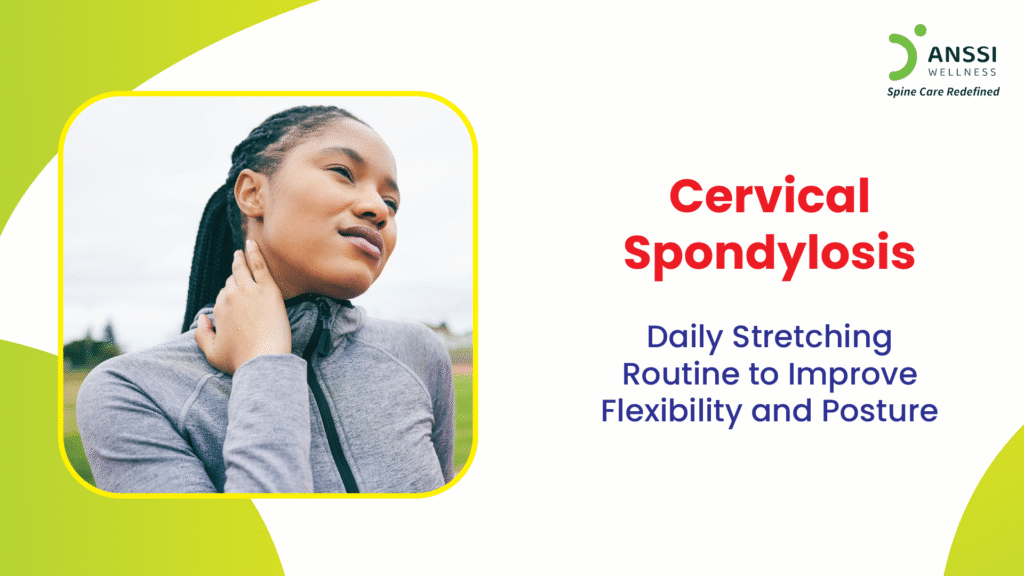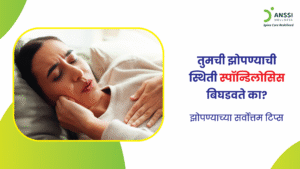Cervical spondylosis, often referred to as neck arthritis or cervical osteoarthritis, is one of the most common spine conditions affecting adults. In fact, by age 65, around 95% of people suffer from cervical spondylosis to some degree.
Caused by the gradual wear and tear of the spinal discs and joints in the neck, it can lead to pain, stiffness, and reduced mobility. In today’s digital age, where hours of work and leisure revolve around computers, smartphones, and sedentary habits, cervical spondylosis is no longer limited to ageing individuals, as it is increasingly affecting younger professionals too.
The good news? With a few simple daily stretches and posture correction habits, you can prevent stiffness, improve flexibility, and support your spinal alignment naturally.
Understanding Cervical Spondylosis
Cervical spondylosis occurs when the intervertebral discs in the neck lose hydration and elasticity over time. As a result, the discs shrink, reducing cushioning between vertebrae and causing friction, stiffness, and sometimes nerve compression. Poor posture, repetitive strain from looking down at screens, and lack of movement can worsen this condition.
Over time, these issues can cause persistent neck pain, shoulder tightness, headaches, tingling sensations in the arms or hands, and difficulty turning the head. However, many of these symptoms can be managed or prevented with proper neck movement, muscle strengthening, and ergonomic awareness.
Why Stretching Matters
Regular stretching is one of the simplest yet most powerful ways to manage cervical spondylosis. It works by increasing flexibility, improving blood flow to muscles and joints, and reducing stiffness that builds up from poor posture.
Here’s how a consistent stretching routine helps:
- Improves circulation: Gentle stretching increases oxygen and nutrient supply to muscles, aiding recovery and reducing inflammation.
- Reduces stiffness: It loosens tight muscles in the neck and shoulders that restrict movement.
- Supports spinal alignment: Regular stretching corrects forward head posture and prevents abnormal pressure on the cervical spine.
- Prevents pain flare-ups: Keeping the neck mobile reduces the likelihood of nerve irritation and muscle spasms.
When combined with an ergonomic workspace and mindful posture habits, stretching becomes an effective daily therapy for long-term neck comfort and spinal health.
Daily Stretching Routine for Cervical Spondylosis
You don’t need to spend hours in the gym or attend special classes to keep your neck healthy. A 10-15 minute daily stretching routine can make a significant difference.
It is generally recommended to perform the following stretches twice daily, especially after waking up and during work breaks, to keep your neck muscles active and pain-free.
1. Neck Tilts (Side to Side)
Sit or stand tall. Slowly tilt your head toward your right shoulder until you feel a gentle stretch on the left side of your neck. Stay in that position for 10 seconds, then return to the centre. Repeat on the other side. Perform 5 reps per side.
Benefits: Improves flexibility and releases tension from the sides of the neck.
2. Chin Tucks
While sitting or standing, tuck your chin slightly toward your chest as if making a double chin. Keep your eyes forward. Stay in that position for 5 seconds and repeat 10 times.
Benefits: Strengthens deep neck flexors and corrects forward head posture.
3. Shoulder Rolls
Lift your shoulders toward your ears and roll them backward in a circular motion. Repeat 10 times, then reverse the direction.
Benefits: Relieves shoulder and upper back stiffness caused by long hours at a desk.
4. Upper Trapezius Stretch:
Place your right hand behind your back and use your left hand to gently tilt your head toward your left shoulder. Hold for 10-15 seconds. Repeat on the other side.
Benefits: Reduces tightness in the upper trapezius muscles that commonly cause neck pain and headaches.
5. Thoracic Extension:
Sit on a chair with a backrest that reaches your mid-back. Place your hands behind your head and gently arch backward over the backrest. Hold for 10 seconds and repeat 5 times.
Benefits: Improves upper back mobility and maintains the natural curve of the spine.
Additional Tips for Neck Health
While stretching forms the foundation of self-care for cervical spondylosis, it’s equally important to make lifestyle adjustments that support spinal wellness.
- Maintain good posture: Keep your computer screen at eye level, shoulders relaxed, and back supported. Avoid leaning forward for long periods.
- Take regular breaks: Every 30-45 minutes, stand up, move around, and gently roll your shoulders and neck.
- Sleep ergonomically: Use a supportive pillow that keeps your head aligned with your spine. Avoid stacking multiple pillows.
- Stay hydrated: Spinal discs need hydration to maintain flexibility and cushioning. Drink adequate water throughout the day.
- Strengthen the core: Strong abdominal and back muscles help stabilise the spine and reduce stress on the neck.
When to Seek Professional Help
If neck pain persists despite regular stretching and posture correction, it may indicate underlying spinal issues such as disc degeneration, nerve compression, or muscle imbalance. In such cases, professional evaluation is necessary.
Non-surgical treatments like spinal decompression, physiotherapy, and targeted posture correction can effectively relieve chronic neck pain without surgery or medication. Non-surgical spinal decompression treatment, for example, uses advanced technology to gently stretch the spine, reduce disc pressure, and improve healing by increasing nutrient flow to affected areas.
About ANSSI:
ANSSI Wellness focuses on improving the quality of life for patients suffering from spinal issues, aiming to provide relief where other conventional treatments have failed. Through advanced Non-Surgical Spinal Decompression Treatment, ANSSI is committed to helping patients avoid surgery and recover in a safe, effective, and compassionate environment.
Connect with ANSSI Wellness on LinkedIn, Instagram, and Facebook for expert guidance.




